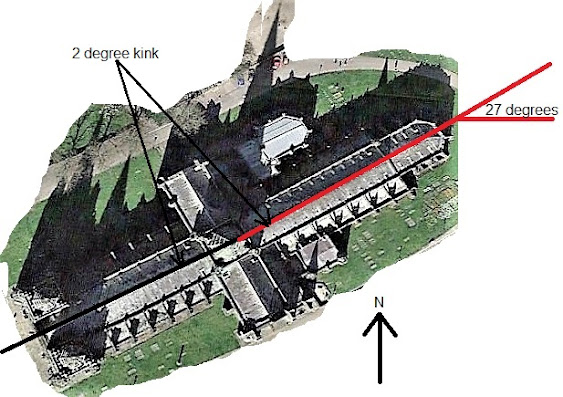Summary.The conventional view that Christian buildings and burials are strictly east-west in alignment does not apply much to the cathedral. The cathedral is out-of-line by 27 degrees and many burials show a chaotic alignment. Explanations for the orientation of the cathedral are unsupported and the best view is the builders were having to take into account the topography of the bedrock.
One of the first observations made by visitors looking along the cathedral is it is not straight. The nave to the central tower and transepts appears not to be the same alignment as the tower along the choir to the east end chapel. It has a 2o kink. The explanation can only be a defect in the building and a consequence of constructing in sections at different times in the 13th-century.
The
cathedral is also out-of-line on an east-west axis. Robert Plot stated the
cathedral declined by 27 degrees from the true points.[1] He
gave several curious theories why churches should face due east and why there
was a declination.[2]
 |
| View of cathedral from Google Maps. |
There are many graves in the Close
which are not strictly facing east.
[1] R. Plot, The Natural History of Staffordshire, (Oxford: 1686), 362–9. Plot found the deviation when taking a compass to the ‘battlements of the middle steeple.’ He justified the east as being significant by citing various events from the Bible, mostly Old Testament. He believed the church should have faced the equinox rise of the sun, but had a blemish, p367. He thought Bishop Roger Clinton was to blame. He concluded the declination from the precise east was not essential for devotion, p368. Other churches not precisely facing eastwards were mentioned, p369.
[2]
Remarked on by R. Willis, ‘On foundations of
early buildings recently discovered in Lichfield Cathedral’, The
Archaeological Journal, (1861), 18, 3.
[3]
H. E. Savage, The fourteenth century builders, Unpub. article in the
cathedral library, (1916), 18.
[4]
Ibid, 20
[5]
N. Orme, Going to Church in Medieval England, (Yale: 2021), 93.

No comments:
Post a Comment